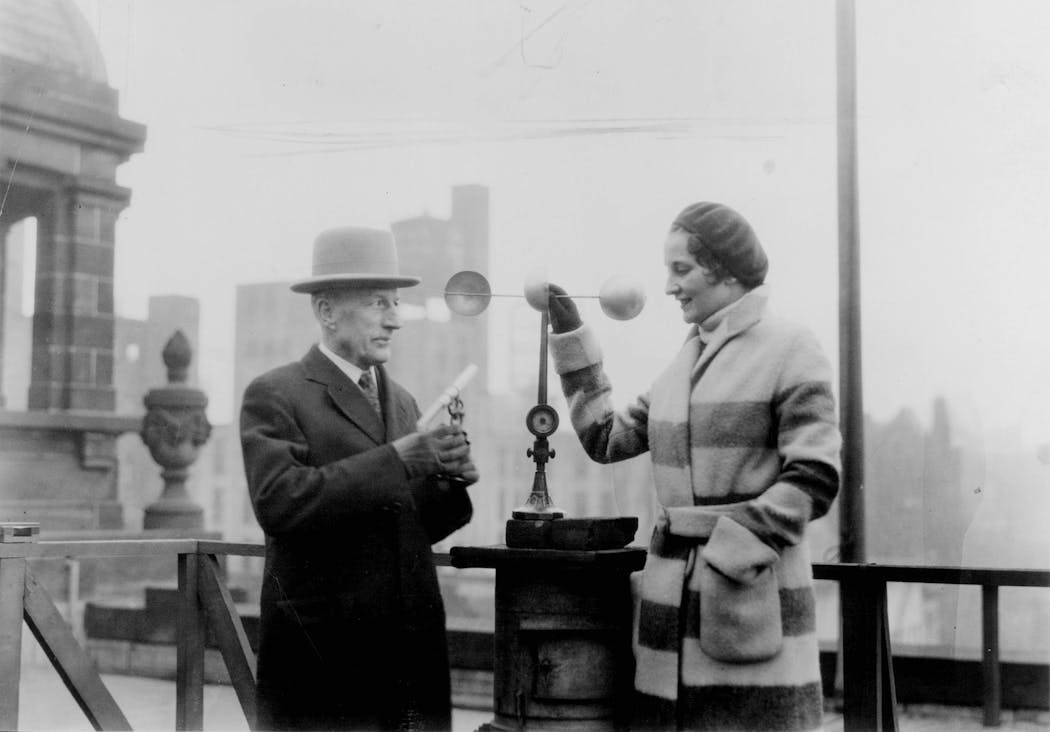Wind gusts are blowing away recent records in Minnesota. But is technology partly to blame?
Listen and subscribe to our podcast: Via Apple Podcasts | Spotify | Stitcher
Climatologist Kenny Blumenfeld has noticed a particular weather topic on people's minds at the many educational events he conducts for Minnesota's Climatology Office.
"We get a lot of questions about wind," he said. "For the last five to 10 years, people who've worked outside have been saying it seems windier."
Reader Nick Magrino — who is a friend of mine — had similar questions after noticing couch cushions being blown around more on the balcony of his Minneapolis condominium. What's more, the wind claimed all the stalks of corn from his balcony garden.
"Usually I would lose one of them," Magrino said. "And this year all three of them got blown over and broke. So I didn't get any corn this year."
Magrino turned to Curious Minnesota, the Star Tribune's reader-powered reporting project, for answers about whether it has in fact been windier lately.
The short answer is yes, though the more precise phrasing is that it has been "gustier" — since high winds are distinct from average wind speeds.
The National Weather Service recorded more days with high wind gusts in each of the last four years than any period in recent history. And 2022 topped them all, setting a new record for the most gusty days. Wind gusts exceeding 30 mph occurred every other day in 2022, on average.
But there is a big caveat to these findings, which is that new wind sensor technology at Minneapolis-St. Paul International Airport could be responsible for some part of the increase.
Wind sensors evolve
The National Weather Service — formerly called the U.S. Weather Bureau — has been tracking the intricacies of Minnesota's weather since the 19th century.
Official measurements were once taken atop the since-demolished federal building in downtown Minneapolis. That process moved to Wold-Chamberlain Field — now Minneapolis-St. Paul International Airport — in 1938 and has remained there ever since.
Weather observers historically recorded wind speed manually by regularly monitoring a cup-style anemometer, which spins in breezy conditions. That process was then automated to take regular digital readings in the mid-1990s.
"The problem with the cups is that when it's icy or when there's snow on them, they're no longer as accurate," said Brian Hirsch, transportation meteorologist at the National Weather Service's Kansas City regional office — which oversees Minnesota. "And they can ice totally up to where they don't turn."
In 2006, the Weather Service implemented ultrasonic technology for measuring wind at MSP airport. That device has no moving parts and heats up to deter ice. It measures the speed of pulses moving from one sensor to another — which is affected by the wind.
That particular device — used at weather stations across the country — eventually became obsolete as parts for it were no longer made. So in 2018, the airport upgraded to the Weather Service's new standard ultrasonic sensor. This roughly coincided with the recent rise in recorded gusty days.
A 2017 national evaluation that did not involve Minnesota found that the new wind sensor produced "comparably representative" wind data to the old one. The two sensors were not tested side by side, however.
"It is not our expectation that there would be a change" based on the sensors, Hirsch said. "And the reason for that is that we want to make sure that we have apples and apples in our datasets."
The gustiest year?
Blumenfeld, with the Climatology Office, said the record 2022 gustiness at MSP airport was matched by other Minnesota weather stations at Duluth and St. Cloud airports — all of which have the upgraded equipment. Stations with older equipment showed more mixed results — some reflected a recent increase in gusty conditions, others did not.
More anecdotally, someone asks about wind at roughly every talk he gives now, compared to the occasional question in the past.
"I would say that 2022 appears to have been a gusty year, and the period since 2019 appears gusty as well, but we are unable to say if this was truly the gustiest year (or period) in our history," Blumenfeld wrote in an e-mail. "We have some evidence for, and other evidence against."
He added: "I am comfortable saying that we are likely seeing the influences of both the newer sensors, and at least a short-term or recent swing towards gustier conditions. Beyond that, we simply lack evidence."
So why the gustier conditions? Wind is generally caused by pressure differences between two areas. When air presses down on the Earth harder in one area than in another, it results in wind. Blumenfeld said there have been more low-pressure systems coming through the region in recent years.
"So whenever we're in a pattern with lots of weather systems coming through, we're going to have a lot of wind," Blumenfeld said in an interview. Transitional seasons like fall and spring are generally the gustier times of year, he said.
'A challenge' for farmers
Carolyn Olson, vice president of the Minnesota Farm Bureau Federation, has seen the gusty conditions firsthand around her farm in southwestern Minnesota.
Farmers have to pay special attention to wind because they cannot apply weed and insect control sprays in gusty conditions, she said.
"We did hear from some of our friends that it was a challenge this year," said Olson, whose farm does not use the sprays.
Some winds were extreme. Three storms in her county brought winds of up to about 75 mph, which damaged a number of grain bins and elevators. But smaller gusts were also noticeable, she said.
"If your criteria is 30 miles an hour or more, heck yeah, we've had a lot of that this year," Olson said.
If you'd like to submit a Curious Minnesota question, fill out the form below:
Read more Curious Minnesota stories:
What makes manhole covers go airborne during big storms?
Should you really let your car run on cold mornings before driving it?
Why don't farms water their crops at night?
Does water really only flow out of Minnesota — not into it?
Is Minnesota's tiny Lake Itasca the true source of the Mississippi River?
Were Minneapolis' skyways first created to combat the cold – or something else?






